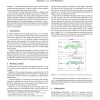Free Online Productivity Tools
i2Speak
i2Symbol
i2OCR
iTex2Img
iWeb2Print
iWeb2Shot
i2Type
iPdf2Split
iPdf2Merge
i2Bopomofo
i2Arabic
i2Style
i2Image
i2PDF
iLatex2Rtf
Sci2ools
123
Voted
ECAI
2008
Springer
2008
Springer
Diagnosis of Simple Temporal Networks
In many domains successful execution of plans requires careful monitoring and repair. Diagnosis of plan execution supports this process by identifying causes of plan failure. Most plans have to satisfy temporal constraints. An important and common occurring problem during plan execution are violations of temporal plan constraints. This paper addresses diagnosis of such temporal constraint violations by modeling the temporal aspects of a plan as a Simple Temporal Network (STN). We investigate the computational properties of standard diagnostic concepts but we also argue that traditional notions of preferred diagnoses such as minimum diagnosis are not adequate. A new notion of a maximum confirmation diagnosis is introduced.
Artificial Intelligence | ECAI 2008 | Plan Execution | Temporal Constraint | Temporal Plan Constraints |
Related Content
| Added | 09 Nov 2010 |
| Updated | 09 Nov 2010 |
| Type | Conference |
| Year | 2008 |
| Where | ECAI |
| Authors | Nico Roos, Cees Witteveen |
Comments (0)

